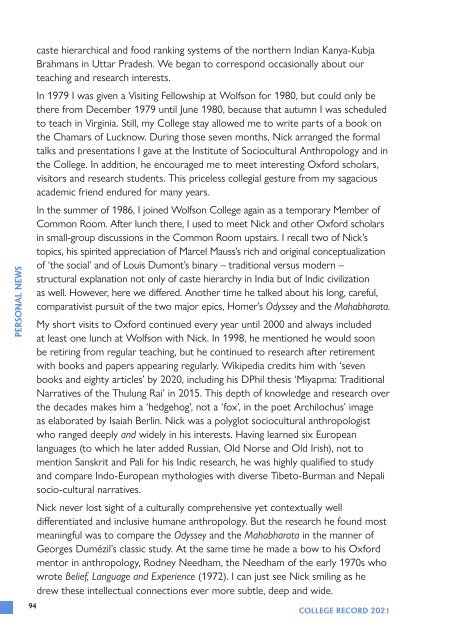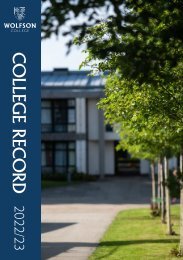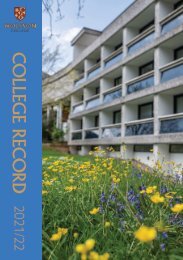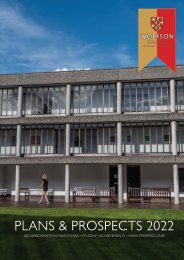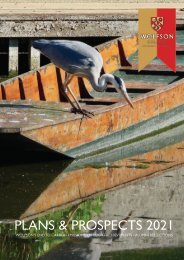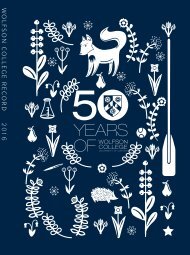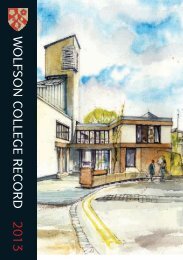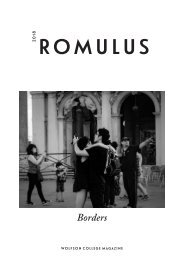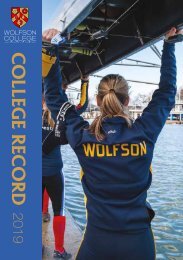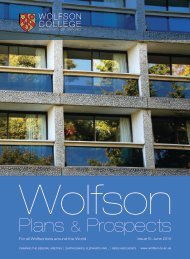Wolfson College Record 2021
You also want an ePaper? Increase the reach of your titles
YUMPU automatically turns print PDFs into web optimized ePapers that Google loves.
Personal News<br />
caste hierarchical and food ranking systems of the northern Indian Kanya-Kubja<br />
Brahmans in Uttar Pradesh. We began to correspond occasionally about our<br />
teaching and research interests.<br />
In 1979 I was given a Visiting Fellowship at <strong>Wolfson</strong> for 1980, but could only be<br />
there from December 1979 until June 1980, because that autumn I was scheduled<br />
to teach in Virginia. Still, my <strong>College</strong> stay allowed me to write parts of a book on<br />
the Chamars of Lucknow. During those seven months, Nick arranged the formal<br />
talks and presentations I gave at the Institute of Sociocultural Anthropology and in<br />
the <strong>College</strong>. In addition, he encouraged me to meet interesting Oxford scholars,<br />
visitors and research students. This priceless collegial gesture from my sagacious<br />
academic friend endured for many years.<br />
In the summer of 1986, I joined <strong>Wolfson</strong> <strong>College</strong> again as a temporary Member of<br />
Common Room. After lunch there, I used to meet Nick and other Oxford scholars<br />
in small-group discussions in the Common Room upstairs. I recall two of Nick’s<br />
topics, his spirited appreciation of Marcel Mauss’s rich and original conceptualization<br />
of ‘the social’ and of Louis Dumont’s binary – traditional versus modern –<br />
structural explanation not only of caste hierarchy in India but of Indic civilization<br />
as well. However, here we differed. Another time he talked about his long, careful,<br />
comparativist pursuit of the two major epics, Homer’s Odyssey and the Mahabharata.<br />
My short visits to Oxford continued every year until 2000 and always included<br />
at least one lunch at <strong>Wolfson</strong> with Nick. In 1998, he mentioned he would soon<br />
be retiring from regular teaching, but he continued to research after retirement<br />
with books and papers appearing regularly. Wikipedia credits him with ‘seven<br />
books and eighty articles’ by 2020, including his DPhil thesis ‘Miyapma: Traditional<br />
Narratives of the Thulung Rai’ in 2015. This depth of knowledge and research over<br />
the decades makes him a ‘hedgehog’, not a ‘fox’, in the poet Archilochus’ image<br />
as elaborated by Isaiah Berlin. Nick was a polyglot sociocultural anthropologist<br />
who ranged deeply and widely in his interests. Having learned six European<br />
languages (to which he later added Russian, Old Norse and Old Irish), not to<br />
mention Sanskrit and Pali for his Indic research, he was highly qualified to study<br />
and compare Indo-European mythologies with diverse Tibeto-Burman and Nepali<br />
socio-cultural narratives.<br />
Nick never lost sight of a culturally comprehensive yet contextually well<br />
differentiated and inclusive humane anthropology. But the research he found most<br />
meaningful was to compare the Odyssey and the Mahabharata in the manner of<br />
Georges Dumézil’s classic study. At the same time he made a bow to his Oxford<br />
mentor in anthropology, Rodney Needham, the Needham of the early 1970s who<br />
wrote Belief, Language and Experience (1972). I can just see Nick smiling as he<br />
drew these intellectual connections ever more subtle, deep and wide.<br />
94<br />
college record <strong>2021</strong>


